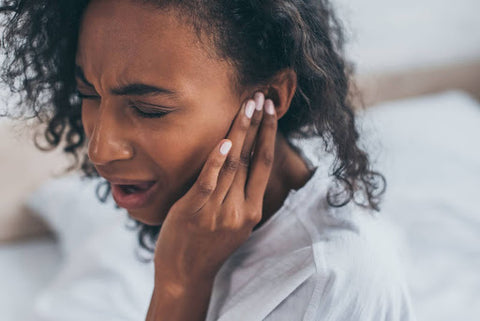Table of Content

TMJ and Ear Pain: Why They're Connected and How to Treat Them
by Dylan Hao |
You’re going about your routine just fine when you begin to notice a little extra ear sensitivity. By the next day, the pain is intense, and you wonder if you need to visit your doctor for antibiotics.
But before you take that step, you might want to look for a few other symptoms.
Ear pain isn’t always directly related to the ear. Instead, it could stem from a tiny, delicate little part underneath the ear called the temporomandibular joint (TMJ).
TMJ disorders frequently cause ear pain because they’re so closely connected to that area.
However, the treatment for an ear infection versus how you care for a TMJ disorder is significantly different. In this blog, we’ll discuss the connection between TMJ issues and ear pain and how to prevent and treat these disorders.
The TMJ and Ear Setup
Your lower facial structure, called the oral cavity, is the space between the lips and cheeks as well as the gums and teeth, including the jaw and skull.
Each part has a separate job, but they’re all interconnected. Your TMJ connects the temporal bone (the side of your skull) and mandible (the lower jawbone). This setup allows movement in hinge-like motions so that you can eat, talk, chew, and yawn instantly.
Although it isn’t part of the oral cavity, the ear canal is connected to the TMJ via a complex network of nerves and blood vessels. This comprehensive, integrated system means that when there’s a problem with your ears, you may notice pain in the jaw and vice versa.
There are over 30 types of TMJ disorders (TMDs), each with their own unique set of symptoms, such as:
- Ear pain
- Jaw pain
- Headaches
- Sinus pressure
- Pain in the eye
However, all TMDs are characterized by pain in the jaw with a limited range of motion.
Because the two areas are so close together, when the TMJ becomes inflamed or is damaged, the change in pressure irritates the nerves and blood vessels in the ears. Your ear pain could stem from a swollen or dysfunctional temporomandibular joint rather than an ear disorder.
How to Tell the Difference Between TMJ Ear Pain and Ear Disorders

So, how do you know if the pain that you’ve noticed in your ear is worthy of an ENT doctor (an ear specialist, officially called an otolaryngologist) or can be treated at home with some TMJ TLC?
Let’s start by reviewing the symptoms that these conditions have in common. Both ear and TMJ disorders can feel like any or all of the following:
- Ear pain
- Ongoing and persistent ringing in the ears (a condition called tinnitus)
- Sensations of ear fullness
- Hearing loss (You may hear sounds as though they’re muffled or far away.)
- Headaches
An ear disorder is typically limited to these symptoms, with the additional signs of vertigo (dizziness) or difficulty staying upright and balanced.
Ear infections are the most common type of problem in this area. However, these usually come during or after sickness and are specific to the middle ear and the eustachian tube.
If you’ve been relatively healthy, you probably don’t have an ear infection. On the other hand, if you have a fever or ear discharge, there’s an infection going on somewhere, and you should see an ENT specialist.
Symptoms Specific to TMDs
If you aren’t dizzy and there’s no sign of infection, there’s a good chance your ear issues are coming from your TMJ. Every TMJ disorder has its own set of symptoms, but you can be confident there’s an issue stemming from this joint if you notice any of the following signs:
- A dull, ongoing irritation in the joint area
- Sharp, searing pain in the joint area
- Difficulty moving the jaw to chew, talk, yawn, or swallow
- Soreness in the neck, head, temple, teeth, lower jaw, cheek, or facial muscles
- Popping or clicking sounds when the mouth opens
- Inability to move the mouth (locked jaw)
- Reduced range of motion in the jaw
- Facial pain
Do these symptoms sound familiar?
If so, that doesn’t mean you necessarily have a long-term problem. In fact, one of the most common causes of TMJ damage is bruxism, and it can be treated from home.
Bruxism and Ear Pain
This condition is frequently referred to as teeth grinding, but it’s more concerning than that. Bruxers clench their jaws tightly without realizing it, usually in their sleep. This powerful jaw clenching for long periods causes significant damage to the muscles, TMJs, teeth, and gums.
Because those areas are interconnected with the ear, ear pain is a warning sign of this condition.
If you have bruxism, you may notice other symptoms like neck pain, morning headaches, and difficulty getting restful sleep. Your dentist can diagnose bruxing easily with an exam and x-rays.
The good news for bruxers is the damage from this problem is often treated effectively with a custom-made nightguard, like those we provide at JS Dental Lab.
Night guards don’t stop the behaviors of clenching and grinding. However, they prevent the upper and lower teeth from touching, which reduces the damage those behaviors can do to your teeth, jaw, and joints.
So, while you still need to reach out to a dentist or other doctor, the solution could be as simple as our mail-order night guard kit! (Here’s how it works.)
But if you don’t think your problem is related to bruxing, keep reading. TMJ-related ear pain can often be treated with some at-home care or careful exercises.
Treating Ear Pain Caused By TMJ
Many mild to moderate TMJ cases go away on their own or with a little special attention from you. TMDs usually stem from overuse of the joint or harm to the facial area.
Unless you’ve had an accident or injury, a little patience and some changes to your day could speed up your recovery without the need to visit the doctor.
At-home Care for TMDs
For the most part, we take our jaw for granted until it starts giving us trouble. Only then do we realize how much we actually use the joint and all its interconnected pieces!
Now that this area is causing your ear pain and other symptoms, you have to pay attention to every minor and major movement of the jaw muscles. Overuse causes swelling and could force the joint out of its proper alignment.
The more you can limit any jaw motions, the sooner your TMJ will likely recover.
While caring for your symptoms at home, do your best to avoid exerting the joint and facial muscles. Skip chewing gum and stick with soft foods. Anything that has to be chewed strenuously, like steak, apples, or caramels, can wait until you’ve resolved your TMD. Stay away from chewy, hard, and sticky foods.
To reduce pain, you can also try these effective at-home remedies:
- Take over-the-counter anti-inflammatories/NSAIDs/pain relievers such as ibuprofen as directed.
- Apply hot and cold compresses along the jaw and facial muscles to soothe the swelling and ease pain.
- Use natural muscle relaxants like peppermint, lavender, and chamomile essential oils.
- Engage in stress-relieving techniques such as yoga, deep breathing exercises, or meditation.
- Take a hot shower to relax the muscles and relieve pain.
- Soak in Epsom salt, another natural muscle relaxant, for quick pain relief.
If a combination of minimizing joint and muscle use and these pain-relieving, swelling reduction therapies don’t offer long-term help, there may be something else going on that a specialist needs to address.
Taking the Next Steps — Visiting a Professional for TMJ Care
Although there’s no sign of an infection, it’s been over a week and your ear pain just won’t go away no matter what you do. It could be time to call your doctor to determine what’s causing the problem.
Depending on how severe your symptoms are, this could mean a prescription for physical therapy. The therapist will teach you exercises to strengthen the jaw muscles. They’ll train you in jaw movement adjustments for side-to-side and open-and-shut motions that reduce damage to the joint, ligaments, and surrounding areas.
After physical therapy, if the symptoms continue, a TMJ specialist is your next step. These doctors handle more severe cases of temporomandibular joint disorder. They can provide you with treatment options like mobilization splints for jaw misalignments to hold your jaw in the proper place.
They’ll also teach you posture training, where your neck and jaw are retrained in how to sit correctly in their natural places. Some specialists offer Botox injections for joint dysfunction to reduce the clicking, hyperactivity, and pain from TMJ conditions. In rare cases, surgery may be necessary.
Preventing TMJ Flare-Ups

Pain treatment is one thing, but wouldn’t it be amazing if you could avoid those flare-ups altogether?
Whether you’re trying at-home care or working with a physician, reducing stress on the jaw joint and facial muscles is crucial.
You can use various methods throughout your day to limit wear and tear and pressure on the TMJ. These techniques minimize your chances of irritating the joint and causing the pain you’re trying to stay away from.
Before you notice ear pain, headaches, or other warning signs that your TMJ is becoming sensitive again, keep these tips in mind to prevent a flare-up:
- Wear your custom-fit night guard consistently. This won’t stop the actions of clenching and grinding, but it will prevent the pressure on the joint and damage to your teeth and jaw.
- Limit stimulants that cause you to have trouble sleeping, like caffeine, alcohol, and tobacco.
- Try to sleep on your back with your neck supported to keep excess stress off your jaw.
- Keep your jaw in a resting position as often as possible. Avoid wide jaw movements, including singing, yelling, yawning, and taking big bites.
- Use chairs with back support if you must sit for long periods, and take frequent breaks to stand and stretch.
- Engage in daily relaxation techniques to loosen and relax the jaw. Yoga, journaling, gardening, and exercise of any type lower your stress hormone level and help you feel calmer.
- Stop bad habits that can damage the TMJ area, such as nail biting, eating ice, chewing on pen caps, and resting your jaw in your hand.
- Adjust your diet to avoid crunchy, chewy, sticky, and hard foods. As a general rule of thumb, if the food requires a big bite or prolonged chewing, just say no.
These habit changes may take some time to adjust to, but an easy reminder when you do something you aren’t supposed to do will be the TMJ pain.
Over time, these avoidance tactics will become lifestyle changes you’re happy to include in your day as your earaches and other symptoms disappear.
Conclusion
Recognizing the cause of your ear pain is the crucial first step in understanding how to treat it.
When there’s no sign of an infection or another cause to worry that it’s an ear disorder, the next most likely cause is a TMJ issue.
Before heading to the doctor for an expensive medical visit and treatment options, check out our professional night guard solutions at our JS Dental Lab website!
